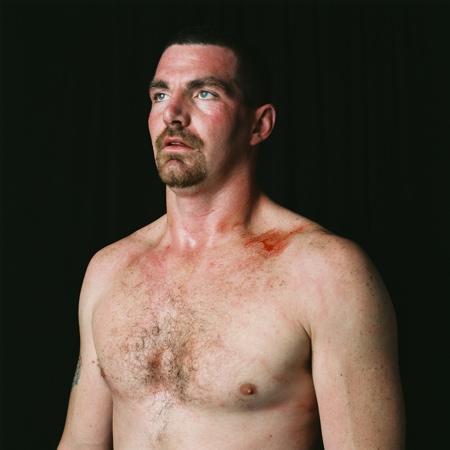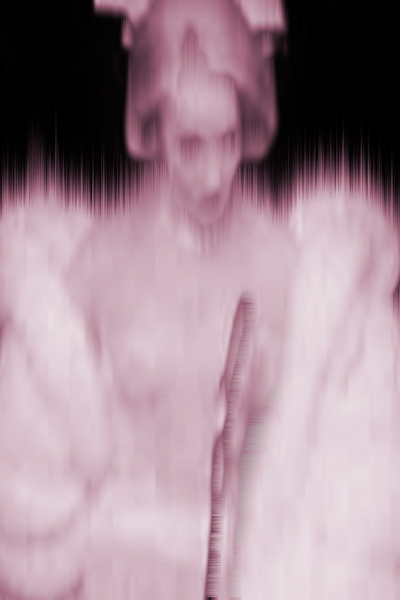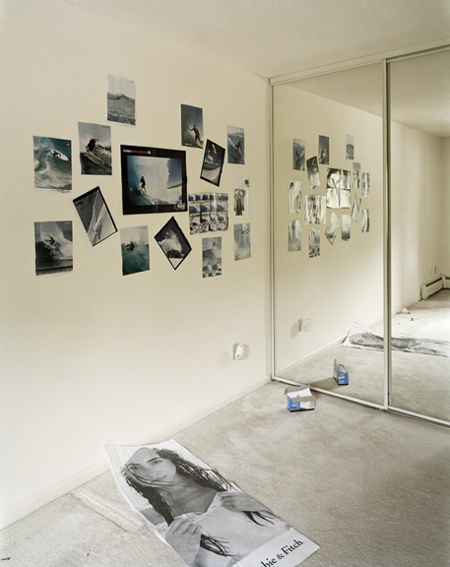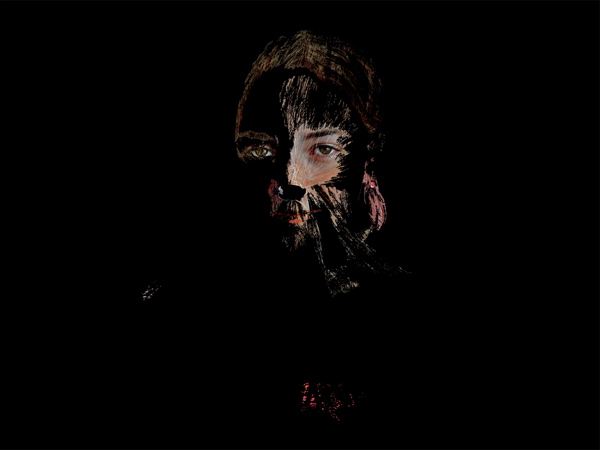Moving Intelligence: “Only Human” at the MMAA
Suzanne Szucs covers "Only Human": portraits--both traditional and not--at the Minnesota Museum of American Art at 50 W. Kellogg Blvd. in St Paul. It's an adventurous and interesting show, up through March 26.





With the “Only Human” exhibition at the Minnesota Museum of American Art, Theresa Downing has put together a group of works that challenge traditional portraiture. These artists, both established and emerging, communicate to both intellect and emotion.
We have been entrenched for centuries in the Cartesian mind-body split, the rational versus the emotional. As if emotions have no reason, we have tended to see the head, reliquary of an intellectualized brain, as the seat of physical identity. This has left the body, holder of the heart and emotions, subservient, a mere machine to bring the intellect around to all the right parties.
Artists in the twentieth century struggled with this notion. The machine age created wonder at the body for its magnificent abilities; at the same time it could be reduced to a vessel for the superior powers of the mind. Dziga Vertov reveled in the camera as an extension of the body, Chaplin’s physical prowess lit up the screen, the Futurists looked at time as an extension of the visual world. But did these artists see the body within the sensibility of a portrait? When we think of a portrait, we imagine the illumination of the soul. Can the soul be found in a foot, a hand, or a once-inhabited room? How do we describe what cannot be seen in the visage – our ever-malleable personalities?
Many of the artists represented in “Only Human” address this condition– if not intentionally in their work, then by their presence in the exhibition. Although many of them do use a more traditional portrait form, depicting the face or upper body, several of them use devices to question this approach, investigating, especially electronically, how portraiture and identity are actually linked.
In bringing together a very disparate group of images, Downing has taken full advantage of the MMAA space; the show flows nicely and no body of work is crowded. In general, the work is seen to its best advantage. In choosing work for the exhibition, Downing often went with her emotional intuition; she’s included work from less established artists, who possibly have not quite found their stylistic footing, but who bring vigor to the exhibition as a whole.
One of the most interesting finds is Peter B. Becker Nelson with his project “9 Monologues,” a large video projection of Nelson mimicking and mouthing audio interviews of women answering questions about their lives and relationships. Those interviewed range in age from a young girl to an old woman, and in ideals from feminist to anti-feminist to unformed. Listening to the womens’ voices would be interesting enough, but watching Nelson’s performing face mimicking the gestures of his interviewees is really engaging. The performance and the piece appear to be non-partisan–that is, it makes no real statement about what it means to be a woman, but lets the viewer grapple with these issues. I must admit, as a feminist, I found this piece problematic not because I object to Nelson’s sensibilities or his method, but because it reinforces the binary opposition of male and female genders. It makes one realize, through his conduit, how much of being female is measured through maleness. In this respect, the piece becomes too simplistic to sustain. Nevertheless, it is riveting to watch and the potential it represents is exciting.
The work of Xavier Tavera is presented in two sections of the gallery, perhaps because the pieces are gleaned from two different bodies of work. His smaller, more traditional portraits are in the style of August Sander – representations of the individual through their surroundings, honest and straightforward. His “Extreme Fighters” series, although borrowing in execution from Andreas Serrano, represent something more. These portraits of men who have just been in the fighting arena – their bodies still pumping sweat, blood fresh, adrenaline present – embody a religious sensibility that pushes them into iconic status. Lit with the drama of Caravaggio, these three men represent stages of fervor – contempt, intensity, ecstasy. Their presence is a fine anchor to the exhibition. Their presentation, however, needs to be better executed. Wrinkles mar the surface of these large inkjet prints on canvas, interfering with the overall effect.
The work of Ernest Arthur Bryant III is ambitious, if not fully realized. Combining graffiti with portraits and icons, Bryant has created a group of images that wrestle with themes of racism and commercialism. His “Reinterpretation of Black Jesus Through Non-Linear Means” puts Osama Bin Laden, Brainy Smurf (yes, apparently there is a smart one), and the sock monkey all on the same canvas. Bryant doesn’t figure out these relationships for us, he wants us to do the work and assumes that we will devour his hieroglyphics. Like Matthew Barney, who also has developed a code, although on a much more monumental scale, Bryant expects us to search through his imagery and question our assumptions about what we are seeing. Like the other young artists in the exhibition, he doesn’t yet have answers for himself, so the work remains unresolved. Like Nelson, however, his potential is provocative and worth spending time with.
More resolved but less interesting is the work of Jay Wittenberg. His painted portraits of female authors are somber and retreating. The notes for the work suggests that Wittenberg has done extensive research on the women, but besides from the dresses and haircuts, each character is nearly the same – with a dour palette, the figures are presented to us with arms crossed and closed to the viewer, life-sized cameos, soulless portraits.
Suzanne Kosmalski, who Downing said she originally built the theme around, presents a video deconstructing moments of “The Last Performance of Marlene Dietrich.” The digital manipulation is rather simplistic; its highlights are the moments when digital mirroring merge Dietrich, clad in a pink evening gown, with her tuxedoed band leader. This crossing of gender lines forms a commentary on the character of Dietrich, who garnered her own fame through blurring those distinctions. To my eyes, this came together much more succinctly in a single Kosmalski image, “The Last Performance of Marlene Dietrich no 4.” Kosmalski captured a single image of Dietrich from the video, her grand pinkness, arms obscured by her stole, mouth hanging open over and about to devour a microphone. An already blurry image, Kosmalski has enlarged the image to near obscurity three more times, presenting it as a series of four on the wall. Turning the corner to see number 4 first, which consists mostly of the open mouth and phallic shaped microphone, all bathed in fleshy pink, I hovered in front of the image. This single photograph sums up the gender blurring that was Dietrich – the microphone becomes at the same time slit and phallus, her mouth and eyes skeletal, sexualized, male and female. This powerful image, an interesting juxtaposition to Nelson’s gender binary, could easily be freed of the tether of its other three companions.
The empty rooms that Anthony Marchetti has photographed step the furthest away from the figure as rule. As an apartment repainter, Marchetti found himself privy to the residue of former tenants – through his eyes, what they left behind becomes a contradiction to their anonymity. Decorations, posters, writing on walls act like body scarring or tattoos – indications of the characters of those who lived in these places. Marchetti’s carefully composed photographs are filled with beautiful, albeit sterile lighting, as objective as any architectural photograph. There is something haunting about their directness because they force the viewer to make assumptions about what they are seeing. Who the individuals living in these rooms were depends upon our interpretations, our prejudices, our imaginations. In taking that responsibility, we are complicit with the photographs and vulnerable to the opinion of others. I respond to that type of demand upon the viewer – it’s specific and timeless, not so dependant upon events or icons outside of the images, but very simply demands something a viewer may be reluctant to give.
During the opening, David Hamlow drew portraits on invoices, adding the finished images to a wall already filled with drawings from previous exhibitions. In the window hung the carbons – these I had seen earlier in the day beautifully lit with the afternoon sun. Somewhere between portraits and caricatures, the images of Hamlow’s “Friends Portrait Project” remind me of tomb rubbings. Perhaps because of this I preferred the copies on yellow receipt paper. The carbon acting as a mediator affects the copy, adding smudges and imperfections. Our faces twist and change constantly – the copies seem to have this earthy, impermanent quality. I much preferred the interactive nature of this project to that of his other work: creating sculptures with trash he has accumulated over the years. Within the context of the exhibition Hamlow is creating a durational portrait of his excess and the work fits in appropriately with Dowling’s theme. However, I am unable to celebrate the accumulation of his habits because I don’t find that what he has created transcends the source.
Also represented in the exhibition are Katinka Galanos and Ben Olson. The former is difficult to comment upon as there is not really enough of her work to get a feel for it. With Olson I had a difficult time connecting with his paintings and getting past the Schiele influence. I appreciated that this was probably the most emotionally charged work in the exhibition; perhaps the least intellectualized. I imagine that being in a room full of and surrounded by his paintings would have a much different effect. For both Galanos and Olson, their work gets lost among other projects that better command the space.
I admire the fact that though Downing’s show is ambitious she has not tried to exhaust the subject of portraiture but has opened up a line of dialogue with her viewers. The subject of portraiture is so profound that Downing is correct not to try to complete the commentary. “Only Human” offers us a range of possibilities, from how we present ourselves to the world, to what we consume in it, to what we leave behind. Who we are is dependent upon our relationship to society, to each other, to history and to memory. It is important to consider that a portrait is by its nature an interpretation through which we expect to learn something about the subject. Here, the most successful work expects the audience to bring their own interpretations into the gallery. How we do so, in turn, creates our portraits as viewers.
Upcoming events include: Audio Portraits, an evening of short performances that revolve around the portrait. Friday March 10, 7-9pm
For more thoughts on portraiture, read Richard Brilliant’s “Portraiture,” Harvard University Press, 1991